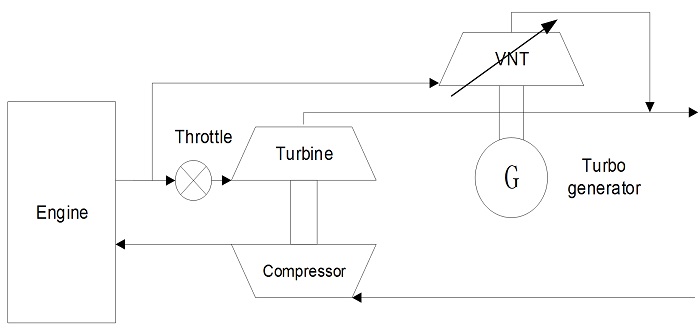A Comparison of Automotive Waste Heat Recovery Systems
Keywords:
waste heat recovery systems, turbo-compounding, organic Rankine cycle, thermoelectricsAbstract
The purpose of this research study is to assess schemes for recovering energy that is lost via an automobile’s exhaust. Three systems for waste heat recovery, viz., (1) electric turbo-compounding, (2) organic Rankine cycles, and (3) thermoelectrics are studied. This involves detailed computer simulations of the waste heat recovery systems, integrated within a vehicle propulsion system operating over certification driving cycles. The simulations suggest that fuel economy improvements of 3-5% could be achieved by converting waste heat into useful work.
References
“U. S. Energy InformationAdministration(EIA),” http://www.eia.gov/forecasts/archive/ieo13/pdf/0484(2013).pdf, 2013.
M. Raghavan, “Propulsion architectures using mechanical energy storage,” Proc. the Institution of Mechanical Engineers, Part K: Journal of Multi-body Dynamics, vol. 230, no. 3, pp. 242-250, 2016.
U. Hopmann and M. C. Algrain, “Diesel engine electric e-turbo compound technology,” SAE Technical Paper, 2003.
F. Millo, F. Mallamo, E. Pautasso, and G. Ganio Mego, “The potential of electric exhaust gas turbocharging for hd diesel engines,” Politecnico di Torino, SAE Technical Paper, 2006.
C. Balis, C. Middlemass, and S. M. Shahed, “Design & development of e-turbo for SUV and light truck applications,” CONF. DEER 2003: Garrett Engine Boosting Systems, June 23, 2003.
C. T. Vuk, “Electric turbo-compounding - a technology whose time has come,” Proc. DEER, Diesel Engine Emissions Reduction Conference, 2003, August 21-25.
W. Wei, W. Zhuge, Y. Zhang, and Y. He, “Comparative study on electric turbo-compounding systems for gasoline engine exhaust energy recovery,” University of Amsterdam, ASME paper GT2010-23204, 2010.
W. Zhuge, L. Huang, W. Wei, Y. Zhang, and Y. He, “Optimization of an electric turbo-compounding system for gasoline engine exhaust energy recovery,” The University of Hong Kong, Department of Mechanical Engineering, SAE Technical Paper, 2011.
M. Kadota and K. Yamamoto, “Advanced transient simulation on hybrid vehicle using rankine cycle system,” SAE International Journal of Engines, vol. 1, no. 1, pp. 240-247, 2008
J. Ringler, M. Seifert, V. Guyotot, and W. Hubner, “Rankine cycle for waste heat recovery of ic engines,” SAE International Journal of Engines , vol. 2, no. 1, pp. 67-76, 2009
H. Teng, J. Klaver, T. Park, G. L. Hunter, and B. van der Velder, “A rankine cycle system for recovering waste heat from hd diesel engines - WHR System Development,” SAE Technical Paper, 2011
T. E. Briggs, R. Wagner, K. D. Edwards, S. Curran, and E. Nafziger, “A waste heat recovery system for light duty diesel engines,” Oak Ridge National Laboratory, SAE Technical Paper, 2010.
Q. Hussain, D. Brigham, and J. Maranville, “Thermoelectric exhaust heat recovery for hybrid vehicles,” SAE International Journal of Engines, vol. 2, no. 1, pp. 1132-1142, 2009.
J. LaGrandeur, D. Crane, and A. Eder, “Vehicle fuel economy improvement through thermoelectric waste heat recovery,” 2005 Diesel Engine-Efficiency and Emissions Research (DEER) Conference, Chicago, IL, August 2008.
R. Stobart, G. Dong, J. Li, and M. A. Wijewardane, “Performance analysis of Tegs applied in the Egr path of a heavy duty engine for a transient drive cycle,” GT Suite Conference, October 2011.

Published
How to Cite
Issue
Section
License
Submission of a manuscript implies: that the work described has not been published before that it is not under consideration for publication elsewhere; that if and when the manuscript is accepted for publication. Authors can retain copyright in their articles with no restrictions. is accepted for publication. Authors can retain copyright of their article with no restrictions.
Since Jan. 01, 2019, AITI will publish new articles with Creative Commons Attribution Non-Commercial License, under The Creative Commons Attribution Non-Commercial 4.0 International (CC BY-NC 4.0) License.
The Creative Commons Attribution Non-Commercial (CC-BY-NC) License permits use, distribution and reproduction in any medium, provided the original work is properly cited and is not used for commercial purposes.



